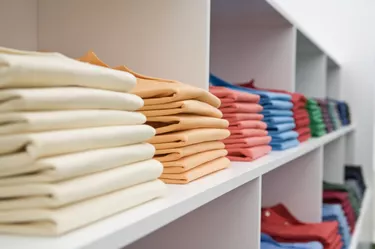
In response to the heavy strain that the clothing production and disposal processes put on the environment, major companies are offering fashion buyback programs to be more sustainable. These programs help keep clothing items out of the landfills and offer financial incentives to attract customers. Not only can you get compensated for turning in your unwanted clothing, but you can also save if you purchase clothes that other customers have turned in. Understanding how the clothing buyback programs work and their alternatives will help you choose the best option.
How Fashion Buyback Programs Work
Video of the Day
While requirements and incentives can depend on the retailer, fashion buyback programs tend to work similarly. The retailer will state whether you can only trade in its products or send clothing items from any maker, and the rules will specify any exclusions. After you gather your items, the retailer might require you to take the items to a local store, or you might initiate an online trade-in request to mail in the items, often with shipping covered.
Video of the Day
Once the retailer receives your items, it will verify that they meet any condition requirements. You'll then receive any compensation offered for your accepted items. This could be a gift card, coupon for a percentage off your next purchase or something else specific to the retailer.
Depending on the company, your items might go up for resale, or they may be recycled or reused in another way. For example, H&M sorts the clothes and then resells the most suitable items, uses less acceptable items to make other products and recycles anything left over.
How Customers Can Benefit
Using a fashion buyback program can help you declutter your closet in a convenient way that also saves you money on future purchases through the retailer.
For example, lululemon provides you with a digital gift card that works online and in person. Examples of compensation include $5 for shirts and shorts, $10 for pants and dresses and $25 for outerwear items. However, your clothing has to be in acceptable condition to receive compensation from lululemon.
If you like shopping for bargains, these buyback programs benefit you especially if you prefer name-brand or luxury clothing. The resalable items usually go on the retailer's website at a discount or may be sold in the store. One example is the Levi's SecondHand website that lets you save on previously worn jeans, shorts and jackets.
Not only can you get compensated for turning in your unwanted clothing, but you can also save if you purchase clothes other customers have turned in.
How the Environment Gets Affected
The World Bank reports that most unwanted clothing gets sent to landfills rather than recycled for other purposes. While companies will still continue to produce new clothing, fashion buyback programs can help reduce the burden by keeping existing clothing items in use for longer. When customers buy used items, they can demand fewer new ones, and this may reduce overall production as well.
A downside to such buyback programs, however, is that usable clothing might still end up thrown away if the retailer excludes the item. For example, Patagonia excludes common items such as hats, T-shirts, shoes, swimwear and yoga clothes.
Considering Other Sustainable Alternatives
Whether you want a more financially advantageous option or your clothing items aren't accepted, you have some alternatives that still help the environment. Your options will depend on whether you're focusing on getting compensation or just want a sustainable way to declutter your wardrobe.
You can always sell your clothes, possibly for more money, to a local resale shop or thrift store. There's also the option to use an online marketplace like ThredUp or eBay. Compensation for these options can widely vary, depending on the clothing's condition, customer demand, retailer policies and other factors.
If you're not worried about compensation, donating to a charity such as Goodwill or the United Way is worth considering. The IRS allows for tax deductions if you itemize and donate items meeting the criteria, so you can consider your tax situation. You can also always reuse the clothing to make something else if you're crafty. For example, if you have some jeans that are torn below the knee, you might solve the issue by making them into shorts.